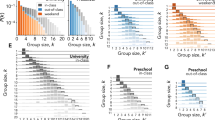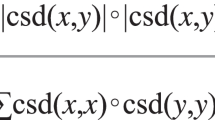Abstract
The research reported here analyses the relationship between group synchrony and group bonding through a novel adaptive computational dynamical system model. By simulating multimodal interactions within a group of four agents, the study uncovers patterns in group cohesion in the sense of emerging multimodal group synchrony and related group bonding. Findings include patterns for emerging group synchrony (logarithmical) and group bonding (logistic). The obtained insights offer an understanding of group interaction dynamics. Future research may consider larger groups and more variations of synchrony detection functions to widen the obtained findings.
Access this chapter
Tax calculation will be finalised at checkout
Purchases are for personal use only
Similar content being viewed by others
References
Abbas, H.A., Shaheen, S.I., Amin, M.H.: Organization of multi-agent systems: an overview. arXiv preprint arXiv:1506.09032 (2015)
Delaherche, E., Chetouani, M., Mahdhaoui, A., Saint-Georges, C., Viaux, S., Cohen, D.: Interpersonal synchrony: a survey of evaluation methods across disciplines. IEEE Trans. Affect. Comput. 3(3), 349–365 (2012)
Louwerse, M.M., Dale, R., Bard, E.G., Jeuniaux, P.: Behavior matching in multimodal communication is synchronized. Cogn. Sci. 36(8), 1404–1426 (2012)
Mataric, M.J.: Designing and understanding adaptive group behavior. Adapt. Behav. 4(1), 51–80 (1995)
Miles, L.K., Lumsden, J., Flannigan, N., Allsop, J.S., Marie, D.: Coordination matters: Interpersonal synchrony influences collaborative problem-solving. Psychology (2017)
Ramseyer, F., Tschacher, W.: Nonverbal synchrony of head-and body-movement in psychotherapy: different signals have different associations with outcome. Front. Psychol. 5, 979 (2014)
Richardson, D., Dale, R., Shockley, K.: Synchrony and swing in conversation: Coordination, temporal dynamics, and communication. Embodied Commun. Hum. Mach., 75–94 (2008)
Rothgangel, A.S., Braun, S.M., Beurskens, A.J., Seitz, R.J., Wade, D.T.: The clinical aspects of mirror therapy in rehabilitation: a systematic review of the literature. Int. J. Rehabil. Res. 34(1), 1–13 (2011)
Rotondo, J.L., Boker, S.M.: Behavioral synchronization in human conversational interaction. Mirror Neurons Evolut. Brain Lang. 42, 151–162 (2002)
Tschacher, W., Rees, G.M., Ramseyer, F.: Nonverbal synchrony and affect in dyadic interactions. Front. Psychol. 5, 1323 (2014)
Wayne, G.D.: Self-modeling neural systems. Columbia University (2013)
Yu, B., Venkatraman, M., Singh, M.P.: An adaptive social network for information access: theoretical and experimental results. Appl. Artif. Intell. 17(1), 21–38 (2003)
Yu, W., Chen, G., Cao, M., Kurths, J.: Second-order consensus for multiagent systems with directed topologies and nonlinear dynamics. IEEE Trans. Syst. Man Cybern. Part B (Cybernet.) 40(3), 881–891 (2009)
Treur, J.: Network-oriented modeling for adaptive networks: Designing Higher-order Adaptive Biological, Mental and Social Network Models. Springer Nature Publishing, Cham, Switzerland. (2020). https://doi.org/10.1007/978-3-030-31445-3
Rothenberg-Elder, K.: Transitional rituals for group initiation and group bonding. In: Farewell and new beginning: The Psychosocial Effects of Religiously Traditional Rites of Passage, pp. 205–225. Springer Fachmedien Wiesbaden, Wiesbaden (2023)
Spoor, J.R., Kelly, J.R.: The evolutionary significance of affect in groups: communication and group bonding. Group Process. Intergroup Relat. 7(4), 398–412 (2004)
Tarr, B., Dunbar, R.I.: The evolutionary role of dance: group bonding but not prosocial altruism. Evol. Behav. Sci. (2023). https://doi.org/10.1037/ebs0000330
von Zimmermann, J., Vicary, S., Sperling, M., Orgs, G., Richardson, D.C.: The choreography of group affiliation. Top. Cogn. Sci. 10(1), 80–94 (2018)
Wood, C., Caldwell-Harris, C., Stopa, A.: The rhythms of discontent: synchrony impedes performance and group functioning in an interdependent coordination task. J. Cogn. Cult. 18(1–2), 154–179 (2018)
Hudson, D., Wiltshire, T.J., Atzmueller, M.: MultiSyncPy: A Python package for assessing multivariate coordination dynamics. Behav. Res. Methods. Res. Methods 55(2), 932–962 (2023)
Meier, D., Tschacher, W.: Beyond dyadic coupling: the method of multivariate Surrogate Synchrony (mv-SUSY). Entropy 23(11), 1385 (2021)
Richardson, M.J., Garcia, R.L., Frank, T.D., Gergor, M., Marsh, K.L.: Measuring group synchrony: a cluster-phase method for analyzing multivariate movement time-series. Front. Physiol. 3, 405 (2012)
dos Santos, N.R., Figueiredo, C., Pais, L.: Development and validation of the organisational cooperation questionnaire. Eur. Rev. Appl. Psychol. 70(4), 100555 (2020)
León-del-Barco, B., Mendo-Lázaro, S., Felipe-Castaño, E., Fajardo-Bullón, F., Iglesias-Gallego, D.: Measuring responsibility and cooperation in learning teams in the university setting: validation of a questionnaire. Front. Psychol. 9, 326 (2018)
Appendix available as linked supplementary data at https://www.researchgate.net/publication/372829620
Hendrikse, S.C.F., Kluiver, S., Treur, J., Wilderjans, T.F., Dikker, S., Koole, S.L.: How virtual agents can learn to synchronize: an adaptive joint decision-making model of psychotherapy. Cogn. Syst. Res. 79, 138–155 (2023)
Hendrikse, S.C.F., Treur, J., Wilderjans, T.F., Dikker, S., Koole, S.L.: On becoming in sync with yourself and others: an adaptive agent model for how persons connect by detecting intra- and interpersonal synchrony. Hum.-Centric Intell. Syst. 3, 123–146 (2023)
Hendrikse, S.C.F., Treur, J., Koole, S.L.: Modeling emerging interpersonal synchrony and its related adaptive short-term affliation and long-term bonding: a second-order multi-adaptive neural agent model. Inter. J. Neural Syst. 33(7) 2350038 (41 pages) (2023)
Author information
Authors and Affiliations
Corresponding author
Editor information
Editors and Affiliations
Rights and permissions
Copyright information
© 2024 The Author(s), under exclusive license to Springer Nature Switzerland AG
About this paper
Cite this paper
Mattera, F., Hendrikse, S.C.F., Treur, J. (2024). An Adaptive Network Model for the Emergence of Group Synchrony and Behavioral Adaptivity for Group Bonding. In: Cherifi, H., Rocha, L.M., Cherifi, C., Donduran, M. (eds) Complex Networks & Their Applications XII. COMPLEX NETWORKS 2023. Studies in Computational Intelligence, vol 1144. Springer, Cham. https://doi.org/10.1007/978-3-031-53503-1_5
Download citation
DOI: https://doi.org/10.1007/978-3-031-53503-1_5
Published:
Publisher Name: Springer, Cham
Print ISBN: 978-3-031-53502-4
Online ISBN: 978-3-031-53503-1
eBook Packages: EngineeringEngineering (R0)




